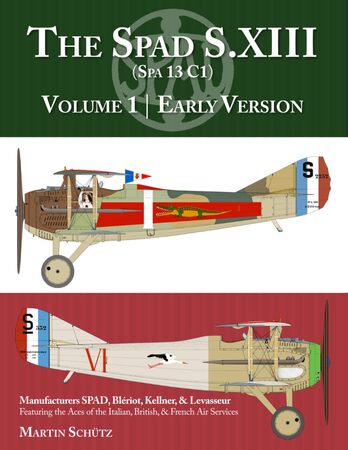
The Spad S.XIII (Spa 13 C1) Volume 1: Early Version
By Matt Bittner
Author: Martin Schütz
Publisher: Aeronaut Books
ISBN: 978-1-953201-76-8
Binding: Softcover
Pages: 285
Brilliant! We are now getting the definitive collection of books on what most call the best Allied fighter of WWI, the Spad 13. This is not only for historians, but is also a modeler's dream! The author - Martin Schütz - is a 1/72 modeler so is answering a lot of questions modelers would have on this aircraft.
Because Volume 1 is concentrating on just the first series of aircraft - including how they differed not only between themselves, but also how they compare (overall) with the later series - there is a definite need to pick up the two other upcoming volumes. There is only one grammatical error thoroughout the text I need to bring to your attention: there are numerous occasions the text refers to a "two-piece canopy". Seeing as the Spad 13 never flew with a canopy, what the text means is a two-piece cowl. There were two different cowl types on the early Spad 13, being either one-piece or two-piece. So replace "two-piece canopy" with "two-piece cowl".
There's a saying, something like if you didn't learn something new on this day, then the day is wasted. There is a lot to learn from this one book. For the modelers, it comes down to how the early version differed than what the model companies provide, as well as how each manufacturer of the Spad 13 changed its look. This is important for finishing your early Spad 13 because the camouflage provided by Kellner was different than the camouflage provided by Levasseur, etc. Plus, the actual SPAD company only produced very few of the early series - maybe 277 - and no other Spad 13 type. Their factory was too small.
There is a chapter devoted to the "ply pockets" that were attached to the few "round wing" early Spad 13 and how to replicate them in 1/72 (Tom's Modelworks to the rescue). Plus you'll need to pay attention to where the fuel filler pipe was, if the forward central wire was covered or not, etc. There is plenty in this book to whet your modeling appetite and help you build the most accurate early Spad 13 possible.
I can not recommend this book enough, especially if you're a Spad 13 aficionado and want to model your Spad 13 as accurately. There are color profiles throughout the book, showing how each manufacturer finished their Spad 13, both uncamouflaged and with the five-color camo. In addition, the back of the book showcases French, Italian and British aces that few the early Spad 13. A modeler's dream come true.
I definitely thank Aeronaut Books for sending this book to review. Contact them direct for ordering information.
